Play review of the game 'Canvas' that stacks transparent cards on the canvas to complete a painting that is more beautiful than anyone else

The Japanese version of ' Canvas ', which was commercialized by collecting about 710,000 dollars (about 77 million yen) at the target amount of 14,000 dollars (about 1.5 million yen) on the crowdfunding site
Canvas Japanese version [released 3/18] --Engames Shop
https://www.engames-s.com/product/2070
The 'canvas' package looks like this, and is designed with the image of an oil painting. The title of the game, the name of the author, the name of the manufacturer, etc. are written on a general game package, but no characters are found on the 'canvas' package.
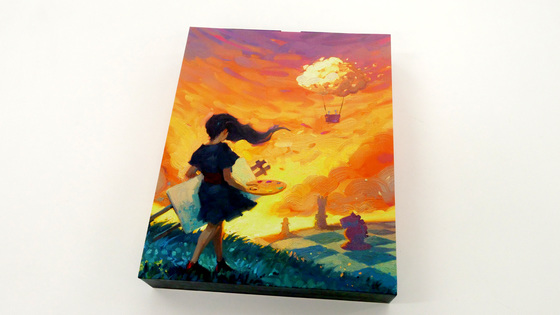
The number of players is 1 to 5, the target age is 14 years old and over, and the play time is assumed to be 30 minutes.
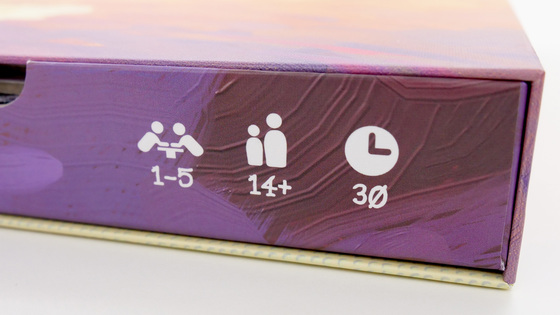
The name and description of the game was written on the back of the package. Also, if you use the hole at the top ...
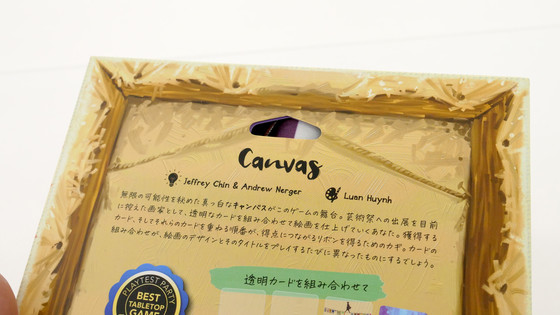
It is also possible to hang it on the wall like this. There are no letters on the package, so it looks like a fine painting.
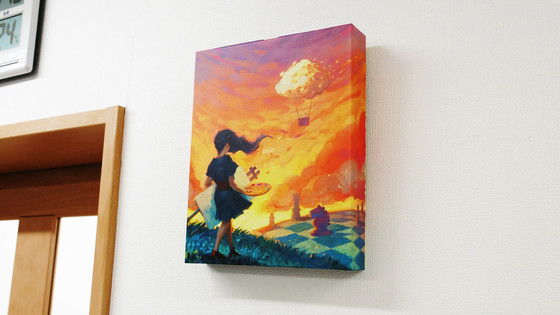
The package is a mechanism that pulls out the inner box from the top like a drawer.
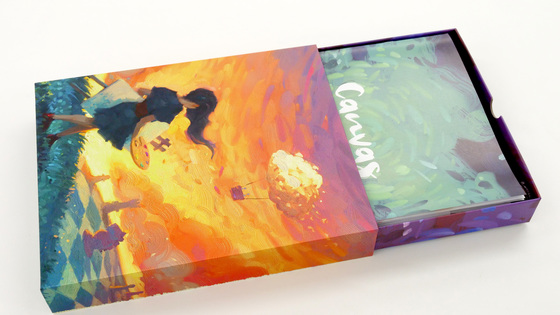
The contents are rule manuals, canvas mats, various cards, deck boxes, transparent card sleeves, and cardboard tokens.
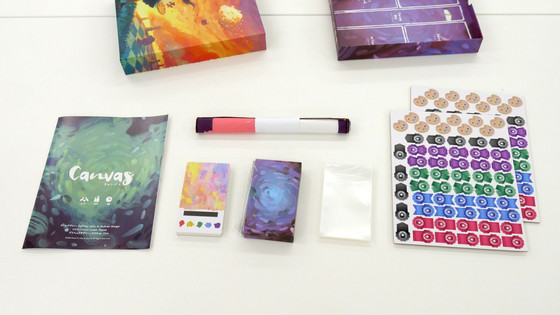
The canvas mat is made of cloth and can be rolled up. When comparing the size side by side with the iPhone 12 mini with a long side of 131.5 mm, it looks like this.
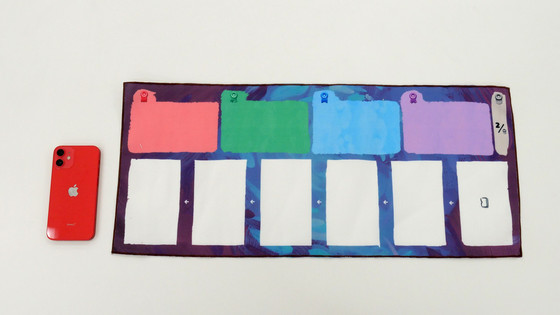
There are 12 'scoring cards' with scoring conditions and 20 'background cards' with the background of the picture.
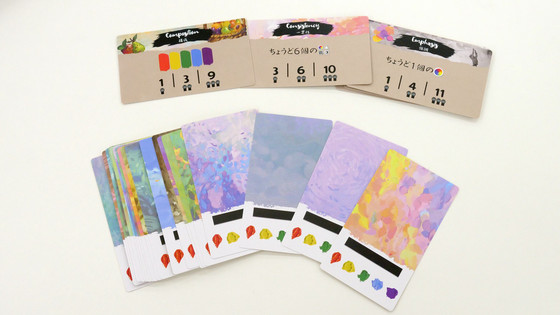
And there are 60 'art cards' made of transparent plastic. Art cards are stored in a cardboard deck box.
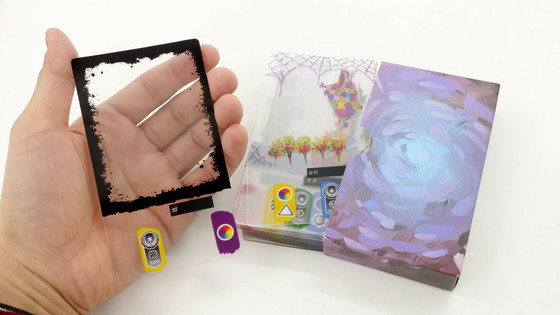
There are 32 transparent card sleeves, which are used to store background cards and scoring cards.
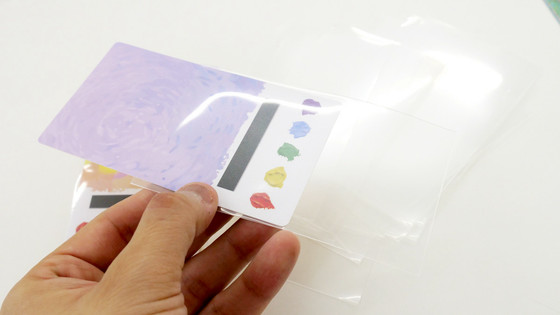
There are 20 ribbon tokens each in 5 types: red, blue, green, purple, and black. In addition, there are 20 palette tokens that imitate the palette of paints.
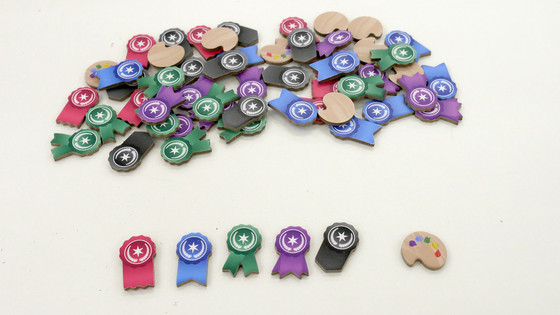
In addition, the place to store each content is specified in the inner box of the package ....
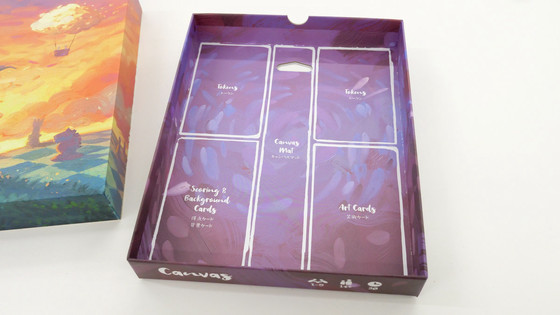
You can store it in an organized state like this.

To play the game, first unfold the canvas mat, line up 4 scoring cards in the upper row, and line up 5 art cards and a deck box in the lower row. Also, arrange the ribbon tokens on the canvas mat as shown below.
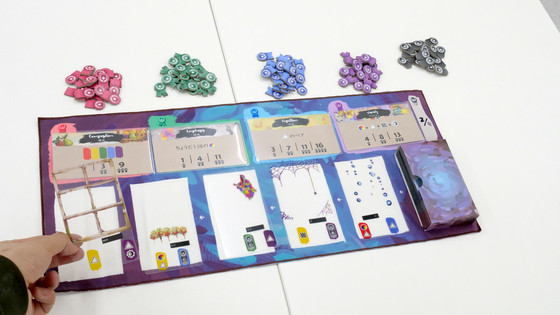
You can freely select and arrange the score cards, but the recommended combination of score cards is listed as a 'scenario' in the rule manual. This time, I decided to play with a combination of ordinary 'first canvas'.
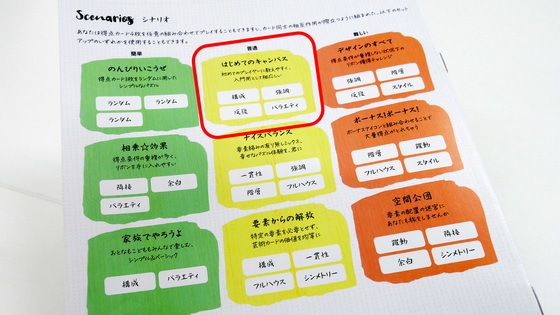
Distribute 3 background cards and 4 palette tokens to each player. This time I played with 4 people.
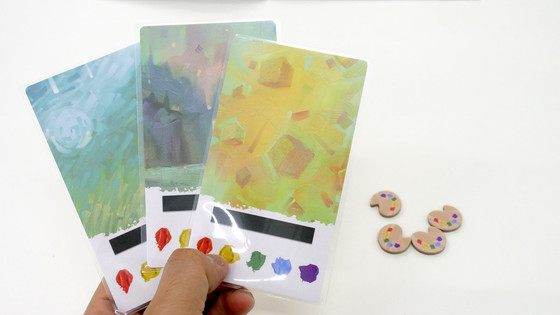
The rules of the game are very simple. The player takes turns and stacks art cards on three background cards to complete three works. Players can either 'acquire art cards' or 'complete their work' in each turn, and the game ends 'when all players have completed three works'. The ribbon tokens obtained according to the result of the work are converted into points, and the player with the highest score wins as 'the painter who received the highest evaluation at the art festival'.
You can get art cards from the canvas mat. For example, if you get the art card placed on the far left ...
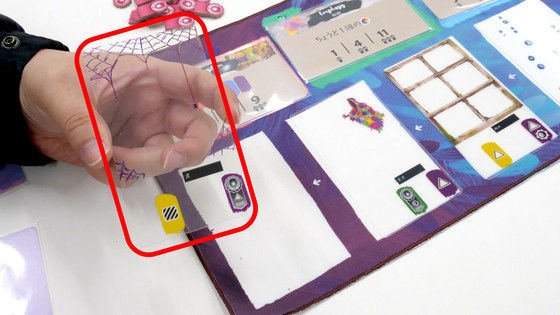
Move the remaining 4 art cards left-justified and place the newly drawn art card from the deck box on the far right.

However, if you have a card on the left side of the art card you want to get, you will have to pay one palette token for each card on the left side. For example, if you want to get the third art card from the left as shown below, place one palette token on each of the two cards on the left. Of course, if you want to get the leftmost card, you don't have to pay the palette tokens.
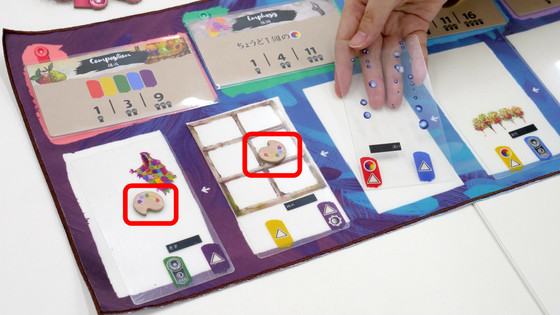
Palette tokens placed on top of art cards will be given to you when you get the card. With that feeling, the beginning of the game is a flow of collecting art cards that each player wants. However, you can only have up to 5 art cards at hand.
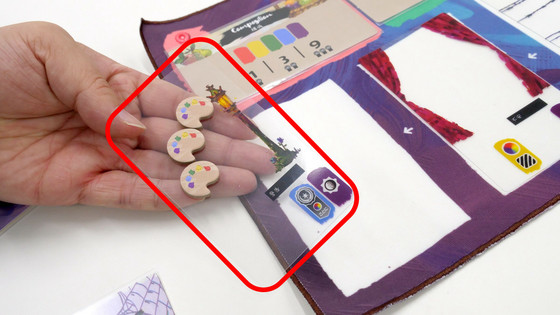
Also, if you have 3 or more art cards at the beginning of your turn, you can complete your work with 3 art cards and 1 background card.
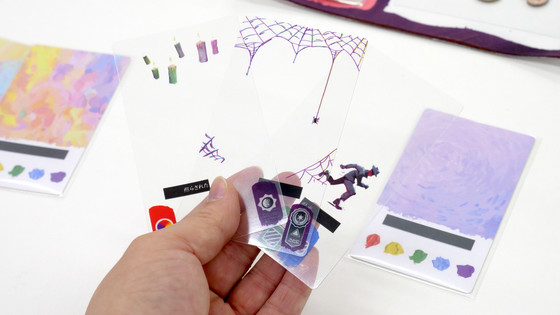
However, just stacking three sheets does not complete a sublime work of art. At the KENPOKU ART 2016, you will be evaluated with 4 points, and you will get a ribbon token by comparing the combination of 5 colors and symbols at the bottom of the work with the conditions of the scoring card.
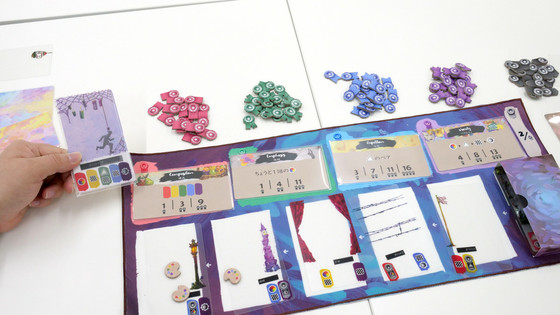
For example, I will present my work using the following three art cards.

The evaluation criteria for this work are as follows. One red ribbon token if all five colors are displayed, one green ribbon token if only one round icon is displayed, one blue ribbon token if two triangle icons are displayed, 4 If all the different symbols are displayed, you can get one purple ribbon token.

In order to raise the evaluation of the work, it is important to stack three sheets. The symbol displayed in the blue part changes depending on how it is layered, such as 'round icon only' or 'triangle icon and round icon'. In this case, if you display 'Triangle icon and round icon', it will be a set with the triangle icon displayed in the purple part, and you will receive more ribbon tokens.
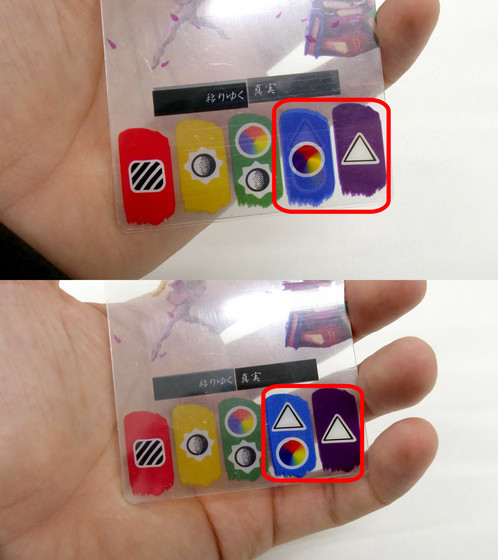
Then, after deciding how to stack the art cards, stack three on the sleeve of the background card as shown below.

Then, the title of the work, 'The Moving Truth,' was announced to everyone and released on the spot. Earn ribbon tokens according to color and symbol.
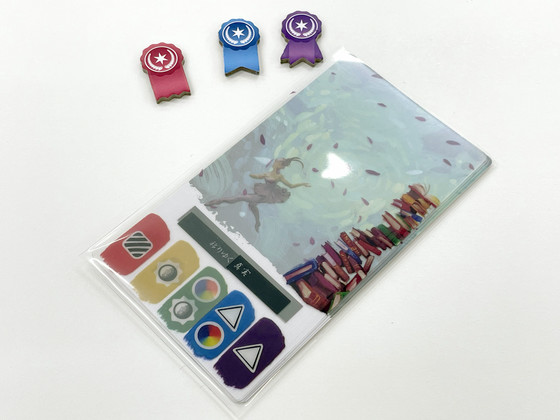
How to combine and superimpose art cards will lead to high evaluation of the work. As a result, players will have to stack up the collected art cards over and over again to try and error how to create a highly acclaimed work.
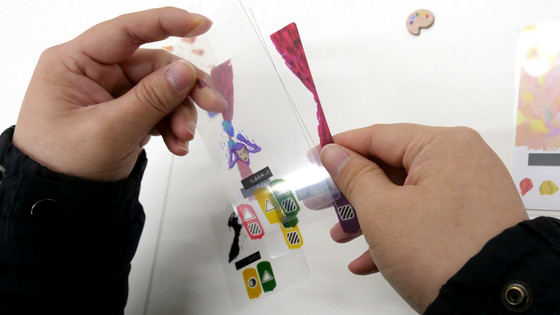
Luck is a big factor in what kind of art card comes into play and whether or not you can bring the art card you are aiming for. Therefore, even if you draw one wonderful work that collects a large amount of ribbon tokens, the next work is often a complete mediocre work.
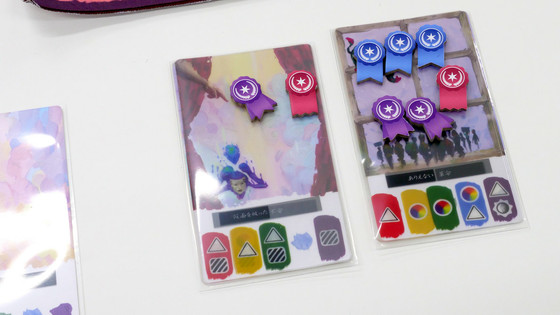
Depending on the combination of colors and symbols, there will be some notable works that will win a large number of ribbon tokens. The following works met all four evaluation criteria, and got black ribbon tokens according to the number of square icons and sun icons, and were praised by all the works that have never been seen before.
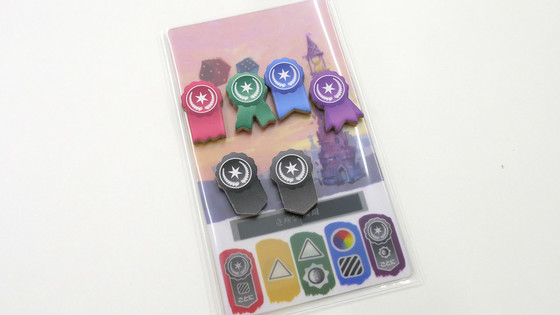
The game ends when all the players complete the three works by completing the art cards and works like that. The artist, who gets the most points, wins by collecting all the ribbon tokens that he has earned and calculating the total score according to the score conversion written on the score card.
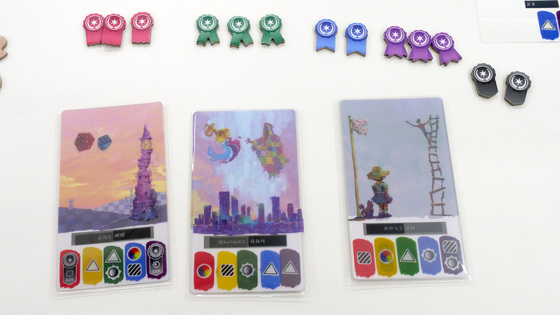
When I actually played 'Canvas', one play took about 30 to 40 minutes. The rules are very simple and easy to understand, and even people who have never played board games can play it without problems. Also, the interface was very good, and there were few scenes where I played the game while staring at the instructions. Even if the rules are simple, the strategy is high enough, and there are countless painting patterns that can be created, so it can be said that the game is very replayable.
Also, the final evaluation point is not determined for each painting, but for the 'total number of ribbon tokens at the end', so there is no such thing as 'a big difference in points at the beginning and the motivation for playing is lowered', so it is casual. I felt that having fun was also a big point.
From the packaging to the contents, such as the canvas mat made of cloth and the carefully designed tokens, it seems to be a game with art motifs, and the visual aspect is very elaborate, which is a big feature of this game. The idea of 'superimposing transparent cards' affects not only the evaluation points of the work but also the workmanship of the paintings and work names, which not only enhances role playability but also creates surrealistic fun. Will give you.
The 'Canvas Japanese version' is scheduled to be released on March 18, 2021, and the suggested retail price is 4400 yen including tax. You can order from the official website below.
Canvas Japanese version [released 3/18] --Engames Shop
https://www.engames-s.com/product/2070
Related Posts:







